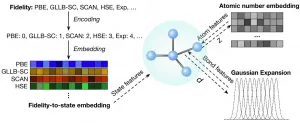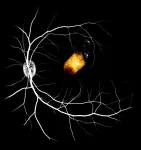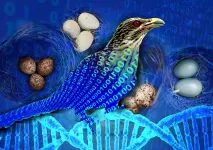INFORMATION:
Funding and support for this research were provided by the Smithsonian, the Global Genome Initiative, the Brazilian National Council for Scientific and Technological Development, the São Paulo Research Foundation and National Geographic.
Scientists discover electric eels hunting in a group
Never-before-seen behavior culminates in a synchronized zap of eels' prey, raising new questions about how they communicate
2021-01-14
(Press-News.org) Deep in the Brazilian Amazon River basin, scientists led by the Smithsonian's National Museum of Natural History fish research associate C. David de Santana discovered a small, river-fed lake filled with more than 100 adult electric eels, many of which were upwards of 4 feet long. On its own, this was an intriguing discovery, electric eels--a type of knifefish rather than true eels--were thought to be solitary creatures.
But in this lake along the banks of the Iriri River in Brazil's state of Pará, the researchers witnessed the eels working together to herd small fish called tetras into tightly packed balls. Then groups of up to 10 eels periodically split off to form cooperative hunting parties, not unlike packs of wolves or pods of killer whales. Those smaller groups then surrounded the prey ball and launched simultaneous electric attacks, stunning the tetras into submission.
"This is an extraordinary discovery," de Santana said. "Nothing like this has ever been documented in electric eels."
De Santana is the senior author of a new paper describing this novel behavior in the Jan. 14 issue of the journal Ecology and Evolution. The findings overturn the idea that these serpentine fish are exclusively solitary predators and open the door to new questions about how these little-understood fish live.
"Hunting in groups is pretty common among mammals, but it's actually quite rare in fishes," de Santana said. "There are only nine other species of fishes known to do this, which makes this finding really special."
This new paper is the latest in a string of revelations driven by de Santana's investigations of the mysterious lives of South America's electric fishes. His pioneering expeditions into the murky, remote waters of the Amazon and its many tributaries have brought to light 85 new species of electric fishes. Just last year, he tripled the number of known species of electric eels, which had stood at one for roughly 250 years.
One of the new species of electric eel presented in his 2019 paper, Volta's electric eel (Electrophorus voltai), is capable of producing 860-volt electric shocks--the strongest electric discharge of any animal on Earth and 210 volts higher than the previous record. The freshly described Volta's electric eel, which can reach lengths of 8 feet, is also the species behind the social hunting strategy at the center of de Santana's new research.
"If you think about it, an individual of this species can produce a discharge of up to 860 volts--so in theory if 10 of them discharged at the same time, they could be producing up to 8,600 volts of electricity," de Santana said. "That's around the same voltage needed to power 100 light bulbs."
Direct measurements of these simultaneous shocks are one of the things de Santana and his colleagues hope to collect on their next expedition to the remote waterways of the Amazon basin. Fortunately for de Santana, who has been shocked more than once by individual eels in the field, the shock only lasts about two-thousandths of a second, but it is enough to cause a painful muscle spasm that might knock a person off their feet.
De Santana's team first witnessed Volta's electric eel hunting in groups during a field expedition in August of 2012. Douglas Bastos, a then Master of Science candidate at Brazil's Instituto Nacional de Pesquisas da Amazônia (INPA) and the paper's first author, travelled five days by boat to explore the fish diversity of the Iriri River. Bastos, now a scientist at INPA, discovered a small lake directly connected with the Iriri River, and to his amazement, the lake held more than 100 adult electric eels.
A subsequent expedition in October 2014 found a similarly prodigious collection of Volta's electric eels in the same locality, which allowed Bastos to document the behavior in greater detail and confirm that it was not just a one-time event. In all, the team logged 72 hours of continuous observation of the eels congregating in this location along the Iriri River.
For the majority of the day and the night, the eels lay almost motionless in the deeper end of the lake, only occasionally coming to the surface to breathe--electric eels get the vast majority of their oxygen from air, an adaptation in response to the low-oxygen waters they sometimes inhabit. But at dusk and dawn the congregation began to stir.
In these twilight hours, the eels started interacting with each other and then began swimming in a large circle. This churning circle of electric eels corralled thousands of the 1-to-2-inch tetras into tighter and tighter shoals. The researchers watched the group herding the concentrated tetras from the deeper end of the lake--around 12 feet deep--to shallow, 3-foot deep waters.
With the tetras trapped by the main group, de Santana says bands of two to 10 eels would separate, move in closer and then launch joint electric attacks on the prey ball. The electric shocks sent the tetras flying out of the water, but when they splashed down the small fish were stunned and motionless. Finally, the attacking eels and their compatriots easily picked off their defenseless prey. According to de Santana, each dawn or dusk hunting ritual took around one hour and contained between five to seven high-voltage attacks.
"This is the only location where this behavior has been observed, but right now we think the eels probably show up every year," de Santana said. "Our initial hypothesis is that this is a relatively rare event that occurs only in places with lots of prey and enough shelter for large numbers of adult eels."
In de Santana's estimation, the team's interviews with locals would have turned up tales of writhing pools filled with electric eels if these gatherings were common. "These animals can be 8 feet long and produce 860-volt electric shocks; if 100 of them being in one place was a common occurrence, I think we would have heard about it before now."
But when the conditions are right, this hunting technique allows the eels to subdue huge quantities of prey that are normally too evasive to capture. Electric eels customarily feed alone at night by sneaking up on sleeping fish and jolting them into an easy-to-eat torpor.
De Santana and his team hope that their newly launched citizen scientist program called Projeto Poraquê may help locate more of these special aggregations of eels. The project, named for an Indigenous Brazilian word for electric eel, will allow users to report sightings and log observations.
Now, de Santana and his colleagues are in the early stages of organizing the next expedition to this unique location along the Iriri. They hope to collect additional tissue samples and mark individual eels with radio tags to understand possible kin relations and hierarchy within the group. De Santana will also aim to take direct measurements of the electrical discharges produced during group hunting to assess their maximum voltage and to determine whether the eels might also be using low-voltage shocks to communicate and orchestrate their efforts, similar to how some marine mammals such as whales and dolphins use sound to coordinate when hunting their prey.
Many of these measurements will be challenging to collect in the field, so de Santana has secured permits to collect eight to 10 adult eels and bring them to a special facility in Germany where he and his collaborators can conduct more controlled tests, which could later be replicated in the field. This would be the first time a group of adult Volta's electric eels has been held in captivity together.
With the Amazon under threat from deforestation, fire and climate change, de Santana said there is a profound sense of urgency to accelerate biodiversity assessment in the region. "Electric eels aren't in immediate danger, but their habitats and ecosystems are under immense pressure. This paper is an example of how much we still don't know, how many organisms whose life histories we don't yet understand."
ELSE PRESS RELEASES FROM THIS DATE:
Environment: Seagrass meadows may facilitate marine plastic removal from the sea
2021-01-14
Underwater seagrass meadows may trap, extract and carry marine plastic debris to shore, thereby helping to remove plastic litter from the sea, according to a study published in Scientific Reports.
Previous research suggested that most plastics end up in the seafloor and that some are washed back to shore; however, how this occurs was unclear.
Seagrass meadows are widespread in shallow coastal waters and are involved in trapping and binding sediment particles that form the seabed. To assess the role that seagrass may have in trapping and removing marine plastic, Anna Sanchez-Vidal and colleagues measured the amount of plastic debris collected from seagrass litter ...
New method makes better predictions of material properties using low quality data
2021-01-14
Advancements in energy technologies, healthcare, semiconductors and food production all have one thing in common: they rely on developing new materials--new combinations of atoms--that have specific properties enabling them to perform a needed function. In the not-too-distant past, the only way to know what properties a material had was by performing experimental measurements or using very expensive computations.
More recently, scientists have been using machine learning algorithms to rapidly predict the properties that certain arrangements of atoms would have. The challenge with this approach is it requires a lot of highly accurate data to train the model, which often does not exist.
By combining large ...
Retinal cell transplant clears experimental hurdle toward treating blindness
2021-01-14
Retinal cells derived from adult human eye stem cells survived when transplanted into the eyes of monkeys, an important early step in the validation of this approach for treating blindness, according to a study by Liu, et al recently published in Stem Cell Reports. The retinal pigment epithelium (RPE), a layer of pigmented cells in the retina, is essential for sustaining normal vision. Blindness due to RPE dysfunction, such as macular degeneration, affects about 200 million people worldwide.
To restore this population of cells, researchers extracted retinal stem cells from donated cadaver adult eyes, grew them into RPE cells and transplanted them into the eyes of monkeys. ...
Scientists take important step toward using retinal cell transplants to treat blindness
2021-01-14
Retinal cells derived from a cadaver human eye survived when transplanted into the eyes of primate models, an important advance in the development of cell therapy to treat blindness, according to a study published on January 14 in Stem Cell Reports.
The retinal pigment epithelium (RPE), a layer of pigmented cells in the retina, functions as a barrier and regulator in the eye to maintain normal vision. RPE dysfunction can lead to eye disorders including macular degeneration and can cause blindness, which affects about 200 million people worldwide.
To restore this population of cells, ...
Experts reduce search times for novel high-entropy alloys 13,000-fold using Cuckoo Search
2021-01-14
A major roadblock to computational design of high-entropy alloys has been removed, according to scientists at Iowa State University and Lehigh University. Engineers from the Ames Lab and Lehigh University's Department of Mechanical Engineering and Mechanics have developed a process that reduces search time used for predictive design 13,000-fold.
According to Ganesh Balasubramanian, an associate professor at Lehigh, the goal of the team's research was to accelerate the computational modeling of complex alloys. The tools available for creating random distribution of atoms in materials simulation models, he says, have been used for many, many years now and are limited in ...
Cancer screening tests, cancer diagnoses during COVID-19 pandemic
2021-01-14
What The Study Did: The number of patients undergoing cancer screening tests and of subsequent cancer diagnoses during the COVID-19 pandemic in the largest health care system in the northeastern United States was assessed in this study.
Authors: Toni K. Choueiri, M.D., of the Dana-Farber Cancer Institute and Quoc-Dien Trinh, M.D., of Brigham and Women's Hospital in Boston, are the corresponding authors.
To access the embargoed study: Visit our For The Media website at this link https://media.jamanetwork.com/
(doi:10.1001/jamaoncol.2020.7600)
Editor's Note: The article includes conflict ...
Socioeconomic disparities in patient use of telehealth during COVID-19 surge
2021-01-14
What The Study Did: Which demographic and socioeconomic factors were associated with patient participation in telehealth during the COVID-19 pandemic surge was examined in this observational study.
Authors: Ilaaf Darrat, M.D., M.B.A., of the Henry Ford Hospital in Detroit, is the corresponding author.
To access the embargoed study: Visit our For The Media website at this link https://media.jamanetwork.com/
(doi:10.1001/jamaoto.2020.5161)
Editor's Note: Please see the article for additional information, including other authors, author contributions and affiliations, conflict of interest and financial disclosures, ...
Progression of myopia in children after COVID-19 home confinement
2021-01-14
What The Study Did: Researchers investigated the association of home confinement during the COVID-19 outbreak with myopia (nearsightedness) development in school-age children in China.
Authors: Xuehan Qian, M.D., Ph.D., of Tianjin Medical University Eye Hospital in Tianjin, China, is the corresponding author. This is an open access article distributed under the terms of the CC-BY License. © 2021 Wang J et al. JAMA Ophthalmology.
To access the embargoed study: Visit our For The Media website at this link https://media.jamanetwork.com/
(doi:10.1001/jamaophthalmol.2020.6239)
Editor's Note: The ...
Flip the script: cardiac rehabilitation is underused, but a simple change could fix that
2021-01-14
Cardiac rehabilitation is a therapy that combines guided exercise along with heart-healthy lifestyle education that can be life-saving for the majority of people who have had a major cardiac event, such as a heart attack. However, it is underutilized in the United States, with many hospitals referring just 20 percent or fewer of their eligible patients, largely because the referral process can be cumbersome. But new research shows that implementing a simple, easy to use "opt-out" pathway in the electronic health record drastically increased the rate of referrals, which could lead to fewer rehospitalizations and even lowered mortality. Led by researchers at the Perelman School of Medicine ...
Comparing reactions of flu vaccines in older adults
2021-01-14
What The Study Did: Researchers in this randomized clinical trial compared injection-site pain and other reactions among adults age 65 and older who received flu vaccines.
Author: Kenneth E. Schmader, M.D., of the Duke University School of Medicine in Durham, North Carolina, is the corresponding author.
To access the embargoed study: Visit our For The Media website at this link https://media.jamanetwork.com/
(doi:10.1001/jamanetworkopen.2020.31266)
Editor's Note: The article includes conflict of interest and funding/support disclosures. Please see the article for additional information, including other authors, author contributions and affiliations, conflict of interest and financial disclosures, and funding and ...
LAST 30 PRESS RELEASES:
Making lighter work of calculating fluid and heat flow
Normalizing blood sugar can halve heart attack risk
Lowering blood sugar cuts heart attack risk in people with prediabetes
Study links genetic variants to risk of blinding eye disease in premature infants
Non-opioid ‘pain sponge’ therapy halts cartilage degeneration and relieves chronic pain
AI can pick up cultural values by mimicking how kids learn
China’s ecological redlines offer fast track to 30 x 30 global conservation goal
Invisible indoor threats: emerging household contaminants and their growing risks to human health
Adding antibody treatment to chemo boosts outcomes for children with rare cancer
Germline pathogenic variants among women without a history of breast cancer
Tanning beds triple melanoma risk, potentially causing broad DNA damage
Unique bond identified as key to viral infection speed
Indoor tanning makes youthful skin much older on a genetic level
Mouse model sheds new light on the causes and potential solutions to human GI problems linked to muscular dystrophy
The Journal of Nuclear Medicine ahead-of-print tip sheet: December 12, 2025
Smarter tools for peering into the microscopic world
Applications open for funding to conduct research in the Kinsey Institute archives
Global measure underestimates the severity of food insecurity
Child survivors of critical illness are missing out on timely follow up care
Risk-based vs annual breast cancer screening / the WISDOM randomized clinical trial
University of Toronto launches Electric Vehicle Innovation Ontario to accelerate advanced EV technologies and build Canada’s innovation advantage
Early relapse predicts poor outcomes in aggressive blood cancer
American College of Lifestyle Medicine applauds two CMS models aligned with lifestyle medicine practice and reimbursement
Clinical trial finds cannabis use not a barrier to quitting nicotine vaping
Supplemental nutrition assistance program policies and food insecurity
Switching immune cells to “night mode” could limit damage after a heart attack, study suggests
URI-based Global RIghts Project report spotlights continued troubling trends in worldwide inhumane treatment
Neutrophils are less aggressive at night, explaining why nighttime heart attacks cause less damage than daytime events
Menopausal hormone therapy may not pose breast cancer risk for women with BRCA mutations
Mobile health tool may improve quality of life for adolescent and young adult breast cancer survivors
[Press-News.org] Scientists discover electric eels hunting in a groupNever-before-seen behavior culminates in a synchronized zap of eels' prey, raising new questions about how they communicate


